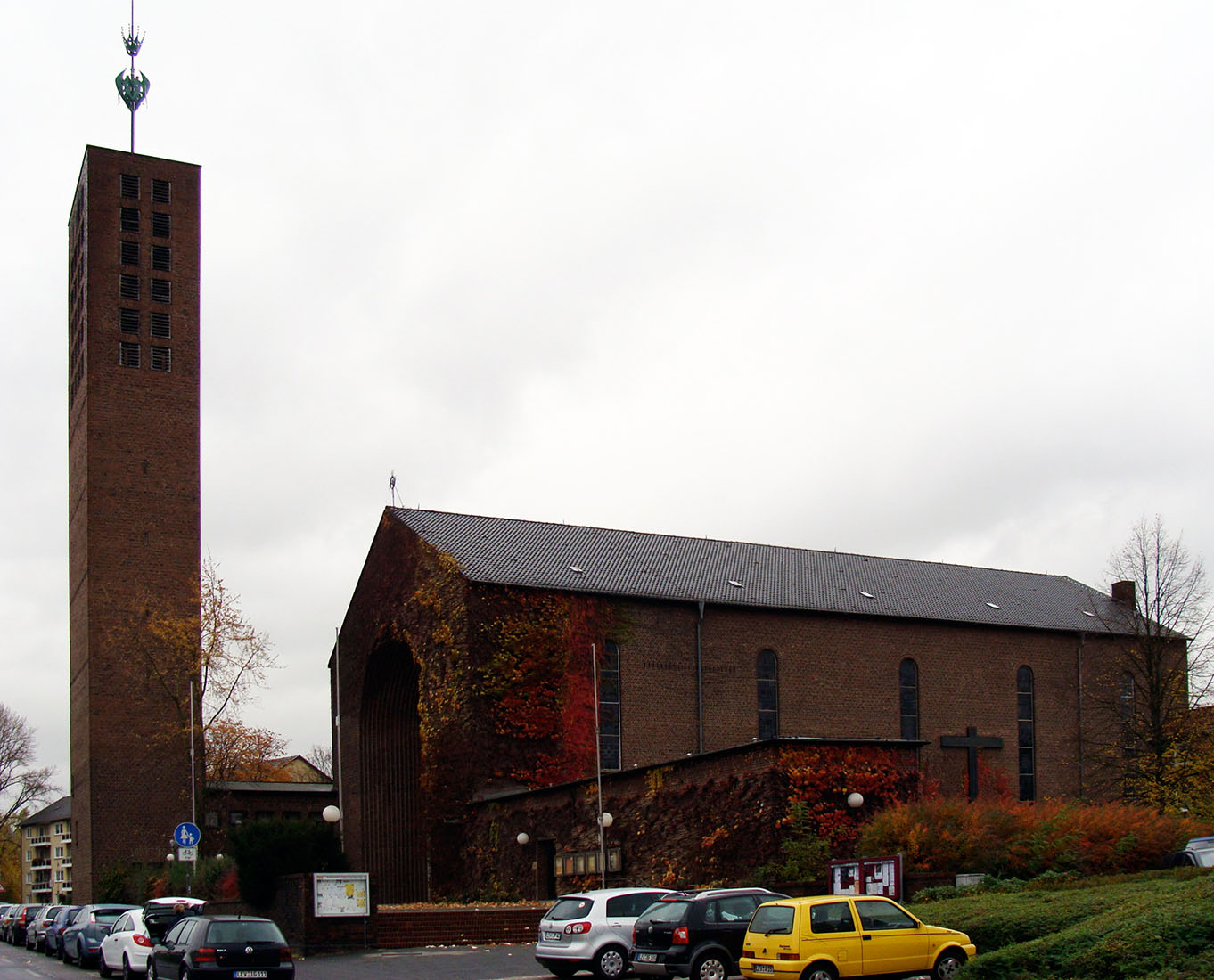 |
 |
 |
 |

Church Christus-König
Pestalozzistrasse 1a, Leverkusen
1927 - 1928
Just
one year after the village church in Lindlar Frielingsdorf Dominikus
Böhm began work on the Christ King Church in Leverkusen-Küppersteg.
Nevertheless, the character of these two churches is entirely different. In the design of the church in Leverkusen Dominikus Böhm diverges from
the clearly structured sacral scheme. The character of Christ King Church resembles rather that of a general purpose building, based on simple geometric shapes.
A rectangular building with gentle sloping gabled roof is complemented on the north side with an addition. This addition with a monopitch roof contains the aisle.
The west elevation in form of a gable wall is dominated by a deep and stepped soffit, containing a high arched window and a portal. On the exterior,
this monumental portal is the only recognizable reference to the religious purpose of the building.
Although the plan may well be compared to the mentioned village church in Frielingsdorf, Dominikus Böhm nevertheless shows a quite different attitude to the space.
The single nave is structured by pilasters, which are penetrated by passages. The transverse choir is offset from the nave by a flight of stairs. The nave and
the choir are determined by cube and right angles. An additional level supported by slender concrete columns serves as an organ loft. The radical nature of the design
is supported by the consistent use of materials. The walls are made of brick, the ceiling is made of wood, the floor made of stone, the windows made of glass
and the equipment is made of concrete. This concise design approach, together with the abstinence of architectural decoration, make the building appear as one of
the most modern churches of its time. However, Dominikus Böhm was inspired by the limited financial resources to build the church in the full-size but without plastering,
painting and a part of the equipment.
The impression of formal sparseness is only opposed by the low lateral aisle which is added on the north side and contains the confessional box.
Covered by semi-circular barrel vaults in longitudinal and transversal direction, the side aisle contrasts with the strict geometrical order of the nave.
With its compact and cavernous character the side aisle strongly contrasts with the nave. The hermetic effect of the vast brick walls is enlivend by
the relief arches and leveling layers which are used as decorative elements, and give the impression of a historically grown building.
Besides the actual church Dominikus Böhm added a single-storey lateral wing as an extension of the west facade. This annex contains the parish library,
a small chapel and the lateral entrance to the church. This small lateral tract is an important part of the overall composition, as it defines the forecourt and
prepares for the experience of the church interior. In addition, the lateral wings are crucial for the arrangement of the volumes and give the rigth scale to the church.
The high tower was built in the second half of the 1950s by Gottfried Böhm, similar to the plans by his father Dominikus.
Nevertheless, the character of these two churches is entirely different. In the design of the church in Leverkusen Dominikus Böhm diverges from
the clearly structured sacral scheme. The character of Christ King Church resembles rather that of a general purpose building, based on simple geometric shapes.
A rectangular building with gentle sloping gabled roof is complemented on the north side with an addition. This addition with a monopitch roof contains the aisle.
The west elevation in form of a gable wall is dominated by a deep and stepped soffit, containing a high arched window and a portal. On the exterior,
this monumental portal is the only recognizable reference to the religious purpose of the building.
Although the plan may well be compared to the mentioned village church in Frielingsdorf, Dominikus Böhm nevertheless shows a quite different attitude to the space.
The single nave is structured by pilasters, which are penetrated by passages. The transverse choir is offset from the nave by a flight of stairs. The nave and
the choir are determined by cube and right angles. An additional level supported by slender concrete columns serves as an organ loft. The radical nature of the design
is supported by the consistent use of materials. The walls are made of brick, the ceiling is made of wood, the floor made of stone, the windows made of glass
and the equipment is made of concrete. This concise design approach, together with the abstinence of architectural decoration, make the building appear as one of
the most modern churches of its time. However, Dominikus Böhm was inspired by the limited financial resources to build the church in the full-size but without plastering,
painting and a part of the equipment.
The impression of formal sparseness is only opposed by the low lateral aisle which is added on the north side and contains the confessional box.
Covered by semi-circular barrel vaults in longitudinal and transversal direction, the side aisle contrasts with the strict geometrical order of the nave.
With its compact and cavernous character the side aisle strongly contrasts with the nave. The hermetic effect of the vast brick walls is enlivend by
the relief arches and leveling layers which are used as decorative elements, and give the impression of a historically grown building.
Besides the actual church Dominikus Böhm added a single-storey lateral wing as an extension of the west facade. This annex contains the parish library,
a small chapel and the lateral entrance to the church. This small lateral tract is an important part of the overall composition, as it defines the forecourt and
prepares for the experience of the church interior. In addition, the lateral wings are crucial for the arrangement of the volumes and give the rigth scale to the church.
The high tower was built in the second half of the 1950s by Gottfried Böhm, similar to the plans by his father Dominikus.
